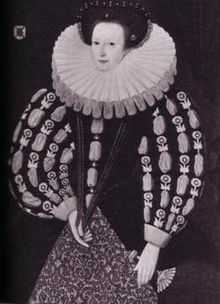Anne Morgan, Baroness Hunsdon
| Anne Morgan | |
|---|---|
| Baroness Hunsdon | |
 Portrait of Anne Morgan, Baroness Hunsdon, painted by a follower of George Gower. It is displayed at Hatfield House | |
| Spouse(s) | Henry Carey, 1st Baron Hunsdon |
|
Issue Sir George Carey, 2nd Baron Hunsdon Sir John Carey, 3rd Baron Hunsdon Henry Carey Thomas Carey Thomas Carey William Carey Sir Edmund Carey Robert Carey, 1st Earl of Monmouth Katherine Carey, Countess of Nottingham Philadelphia Carey Margaret Carey | |
| Father | Sir Thomas Morgan |
| Mother | Anne Whitney |
| Born |
c.1529 Arkestone, Herefordshire, England |
| Died | 19 January 1607 (aged 77–78) |
| Buried | Westminster Abbey, London |
| Occupation |
Lady of the Privy Chamber Keeper of Somerset House |
Anne Morgan, Baroness Hunsdon (c.1529 – 19 January 1607) was the wife of Henry Carey, 1st Baron Hunsdon, by whom she had a total of 12 children. On 14 December 1595, she was appointed by Queen Elizabeth I of England to the office of Keeper of Somerset House; a post which she held for life. She also served the Queen as a Lady of the Privy Chamber.
Family
Anne was born c.1529 at Arkestone, Herefordshire, the daughter of Sir Thomas Morgan and Anne Whitney, herself the daughter of Sir James Whitney and Blanche Milbourne.[1][2] The Morgan family was of Welsh origin.[3]
Marriage and issue
On 21 May 1545, a licence was obtained for the marriage of Anne to Henry Carey, son of Sir William Carey and Mary Boleyn, the elder sister of Queen consort Anne Boleyn. As Carey's mother had once been the mistress of King Henry VIII, many people, including John Hales, vicar of Isleworth, speculated that he was in point of fact, the King's illegitimate son.
Carey was created Baron Hunsdon on 13 January 1559; from that time onward, Anne was styled Baroness Hunsdon.[4] Following her elevation to the rank of a peer's wife, Anne was appointed a Lady of the Privy Chamber to Queen Elizabeth I,[5] who was also her husband's first cousin and held the couple in high favour. Carey was soon afterward appointed Captain of the Gentlemen-at-Arms, making him in actuality, the Queen's personal bodyguard.
A painting by an unknown artist was done to commemorate a visit by the Queen to Anne and Carey at their manor, Hunsdon House in Hertfordshire in September 1571; Anne is believed to be depicted among the Queen's Ladies in the royal procession, as the foremost lady dressed in white.[6]
Anne's portrait was painted by a follower of George Gower, and is displayed at Hatfield House.
Together Henry and Anne had 12 children:
- Sir George Carey, 2nd Baron Hunsdon (1547- 8 September 1603), married Elizabeth Spencer, by whom he had one daughter, Elizabeth.
- Sir John Carey, 3rd Baron Hunsdon (died April 1617), married Mary Hyde, by whom he had issue.
- Henry Carey
- Thomas Carey, died young.
- Thomas Carey, died young.
- William Carey
- Sir Edmund Carey (1558–1637), married three times (Mary Crocker, Elizabeth Neville, Judith Humphrey), and had issue.
- Robert Carey, 1st Earl of Monmouth (1560- 12 April 1639), married Elizabeth Trevannion, by whom he had issue.
- Unnamed son
- Katherine Carey (c.1547- 25 February 1603), married Charles Howard, 1st Earl of Nottingham, by whom she had five children.
- Philadelphia Carey (c.1552- 1627), married Thomas Scrope, 10th Baron Scrope, by whom she had issue.
- Margaret Carey, married Sir Edward Hoby.
Anne's husband had several illegitimate children, including Valentine Carey. One of his mistresses was Emilia Bassano, believed by many, including A. L. Rowse to have been the inspiration for William Shakespeare's sonnet The Dark Lady, due to her black hair and dark complexion. Her son Henry, born in 1592 was possibly fathered by Carey, although he was 68 years old at the time of the child's birth.
Widowhood

When Anne's husband died on 23 July 1596, he left his family in debt. Queen Elizabeth paid for his funeral expenses, and gave Anne a gift of £400, as well as an annual pension of £200 from the Exchequer. Anne used some of the money to erect a monument to her husband in Westminster Abbey.
On 14 December 1595, seven months before Carey's death, Queen Elizabeth had appointed Anne to the office of Keeper of Somerset House, a royal residence where the Queen had lived prior to her ascension to the throne;[7] Anne held the post for life.[8] In 1574, her husband had been made Keeper.
Anne died on 19 January 1607, and was buried in Westminster Abbey. Her will, which was dated 10 January 1607, was proved on 22 January.[9]
References
- ↑ http://www.tudorplace.com.ar/MORGAN.htm#Thomas%20MORGAN%20of%20Arkston1[]
- ↑ Descendants of Robert de WHITNEY (c.1225- ) http://www.ffish.com/family_tree/descendants_robert_de_whitney/d1.htm
- ↑ Nant y Ffin Farm: A History up to 1841, retrieved 2-12-09
- ↑ http://www.the Peerage.com
- ↑ Kathy Lynn Emerson, A Who's Who of Tudor Women, retrieved on 1 December 2009
- ↑ John Nichols, The Progresses and Public Processions of Queen Elizabeth, Volume I, p.288, retrieved 2-12-09
- ↑ http://www.thePeerage.com
- ↑ Emerson
- ↑ http://www.the Peerage.com